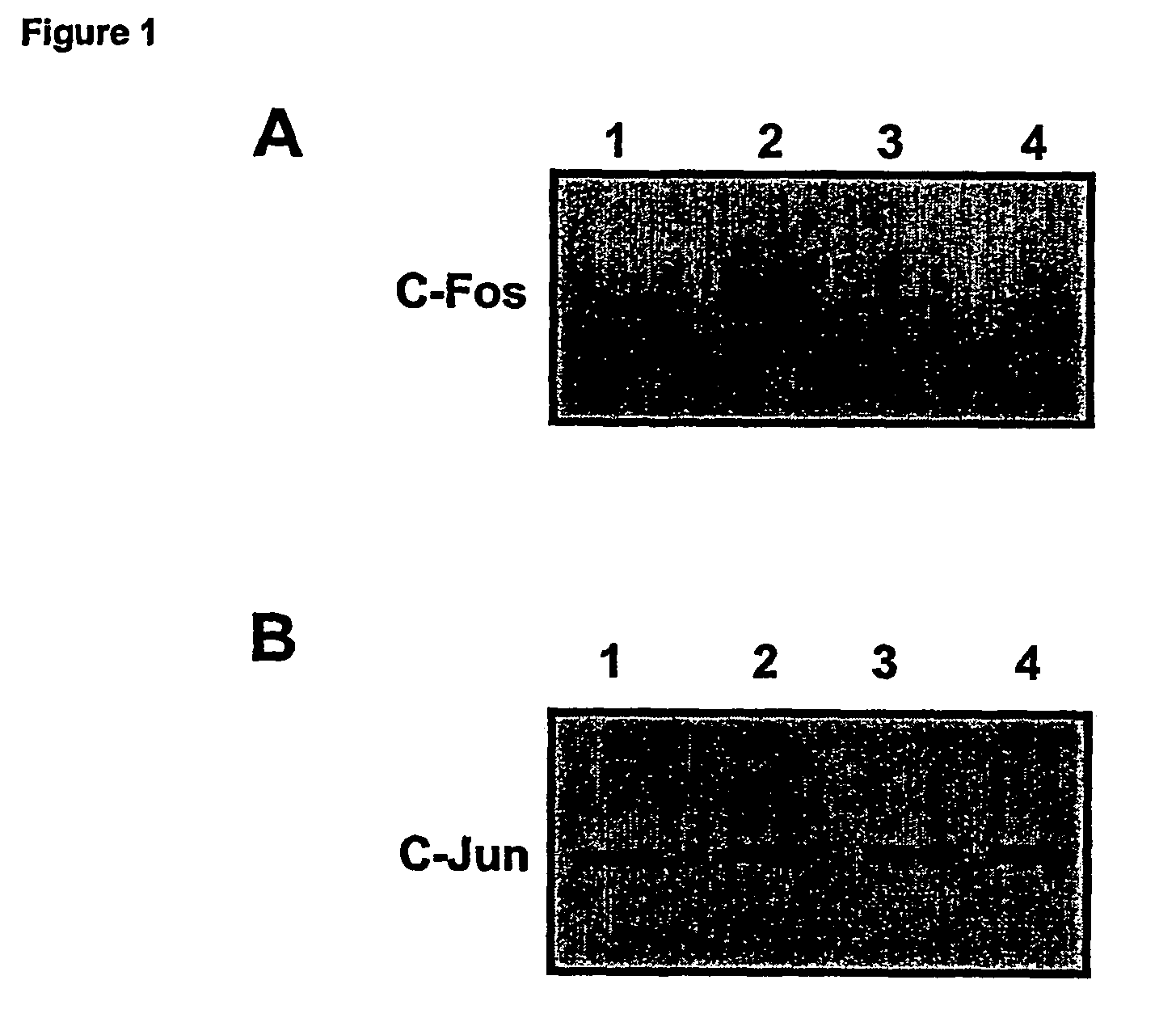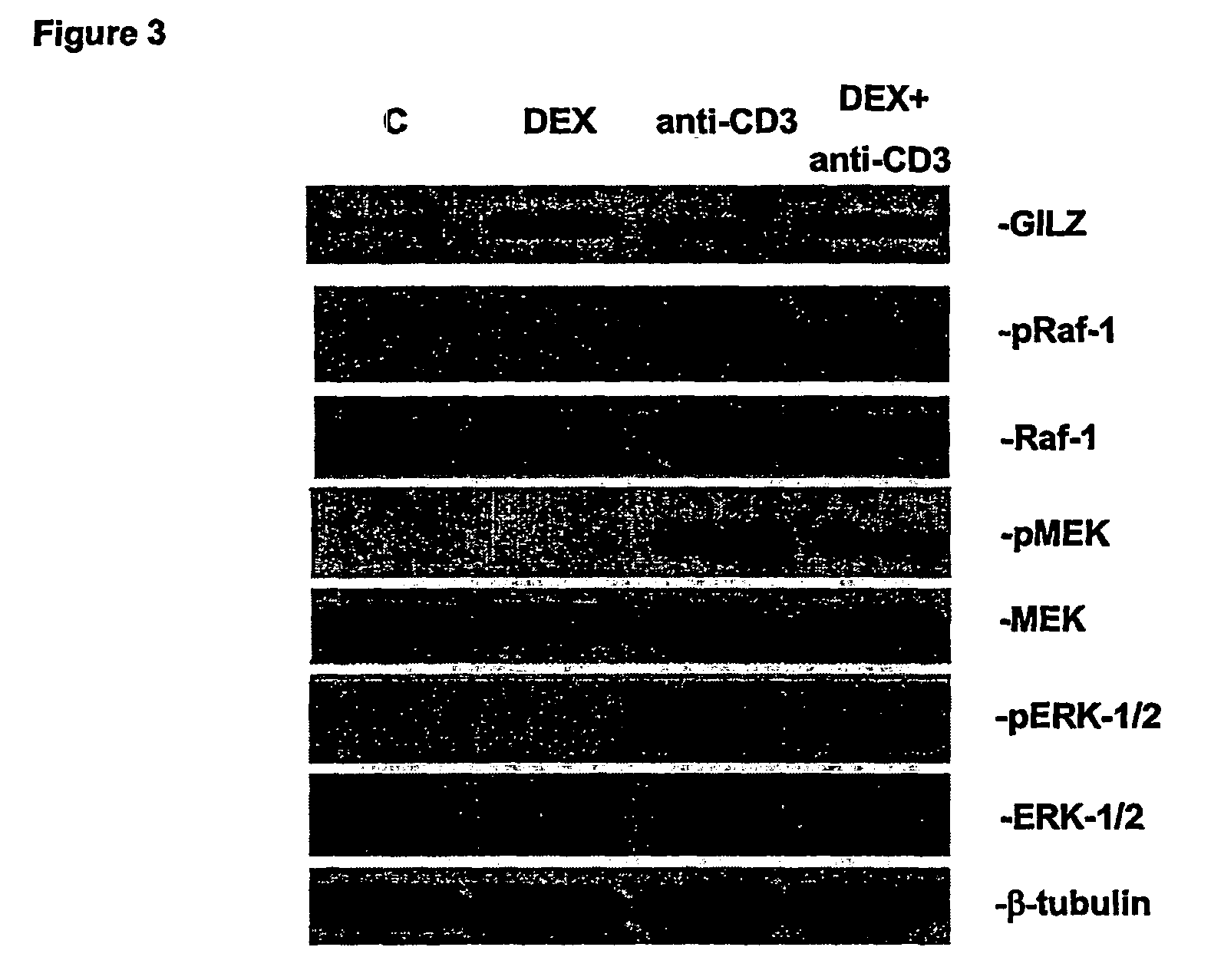Novel raf/ras binding compounds
a technology of binding compounds and raf, which is applied in the field of signal transduction, can solve the problems of not providing any structure-function relationship of gilz interactions and the regulation of raf activity is very complex, and achieves the effect of inhibiting the activation of the signaling pathway
- Summary
- Abstract
- Description
- Claims
- Application Information
AI Technical Summary
Benefits of technology
Problems solved by technology
Method used
Image
Examples
example 1
Effects of GILZ on the Raf-Controlled MAPKs transduction Pathway
Methods
Cell Culture
[0108] The spontaneously dividing CD3+, CD4+, CD2+, CD44+ subtype of the ova-specific hybridoma T-cell line called 3DO and mouse thymocytes have been obtained, characterized, and DEX-treated as described before (Ayroldi E et al., 1997; D'Adamio F et al., 1997). For the latter cell type, spleen and lymph node cells were stained with a saturating concentration of FITC-conjugated anti-mouse B220 (clone RA3-6B2; Pharmingen) followed by incubation with α-FITC conjugated magnetic beads (PerSeptive Diagnostic) for 30 minutes. Magnetic separation of the resulting antibody complexes resulted in yields of T cells with purity≧98%. COS-7 cells were maintained in culture in DMEM medium supplemented with 10% FCS.
Transfection of Cultured Cells and Clone Isolation
[0109] Transfected clones were prepared as previously described (Nocentini G et al., 1997). Briefly, mouse GILZ cDNA coding sequence (414 base pairs...
example 2
Mechanisms of the GILZ-Mediated Inhibition of the Raf-Controlled MAPKs Transduction Pathway
Methods
Immunoprecipitations.
[0129] Immunoprecipitations were performed in RIPA buffer (TRIS (pH 7.5) 50 milliMolar, NaCl 150 milliMolar, Nonidet P-40 1%, deoxycholate 0.5%, sodium dodecyl sulphate. (SDS) 0.1%, and EDTA 5 milliMolar) supplemented with 1 mM PMSF.
[0130] For the immunoprecipitation using whole cell extracts of mouse cells (spleen, lymph nodes, thymocytes and 3DO cells), α-Raf, α-NF-AT, and α-Ras antibodies (Upstate Technology) were used at the concentration of 8 micrograms for each milligram of protein extracts. Antigen-antibody complexes were precipitated with protein A-Sepharose beads (Pharmacia) and dissociated from beads prior to SDS-PAGE by boiling in loading buffer.
[0131] For the immunoprecipitation using whole cell extracts of COS-7 cells, the cells were transfected by the DEAE-dextran method as previously described (Luo Z J et al., 1995), using 2 micrograms of each ...
example 3
Structure-Function Study of the GILZ / Raf Interaction
Methods
GST Fusion Proteins Including GILZ Fragments and GST Pull-Down Experiments
[0144] Glutathione S-transferase fusion protein including diffrent segments of GILZ were prepared by cloning the segment encoding for such GILZ fragments in the plasmid originally described for the expression of GST-GILZ (Ayroldi E et al., 2001). When necessary (i.e. whenever the original GILZ methionine was not included), a Met codon was added by at 5′ of the sequence by normal genetic. The GST pull-down experiments were performed as described in the previous example with 3DO cells.
Radiolabeled GILZ Proteins
[0145] Full, deleted, and mutated mouse GILZ (FIG. 11) were obtained by PCR and cloned in pCR3.1 (Invitrogen). ΔC-GILZ contains the first 97 amino acids of mouse GILZ. DN-GILZ contains the first 8 amino acids of mGILZ fused with the residues 73-137. The in vitro translation with [35S]-Methionine was performed with a commercial rabbit reticu...
PUM
| Property | Measurement | Unit |
|---|---|---|
| Fraction | aaaaa | aaaaa |
| Fraction | aaaaa | aaaaa |
| Fraction | aaaaa | aaaaa |
Abstract
Description
Claims
Application Information
 Login to View More
Login to View More - R&D
- Intellectual Property
- Life Sciences
- Materials
- Tech Scout
- Unparalleled Data Quality
- Higher Quality Content
- 60% Fewer Hallucinations
Browse by: Latest US Patents, China's latest patents, Technical Efficacy Thesaurus, Application Domain, Technology Topic, Popular Technical Reports.
© 2025 PatSnap. All rights reserved.Legal|Privacy policy|Modern Slavery Act Transparency Statement|Sitemap|About US| Contact US: help@patsnap.com



